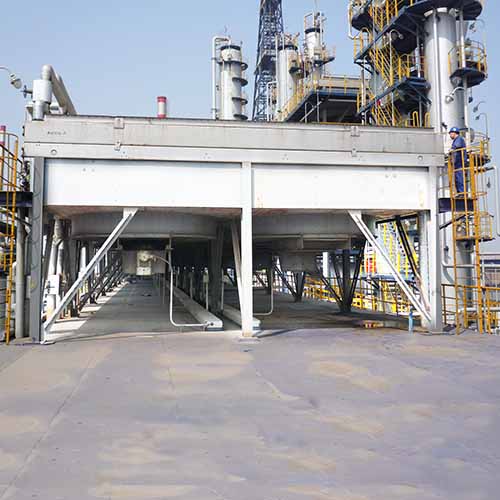Erosion corrosion, including erosion and wear corrosion, is a metal damage caused by high-speed relative motion between the metal surface and the fluid medium. The surface of the eroded metal is bright, generally in the shape of groove, valley or teardrop, with no corrosive deposits. Compared with corrosion under other stresses, the factors affecting the erosion corrosion are more complicating - except for the chemical composition, microstructure, mechanical properties, surface roughness and corrosion resistance of the materials, there are temperature, pH, dissolved oxygen content, granularity and hardness of the medium, as well as the flowing part's shape, structure, flow velocity and regime. In the air cooled heat exchanger, the most likely part of erosion corrosion is the joint between the base pipe and the tube plate, since these two are generally single-layer or double-layer welded. The height of the fillet weld is between 1.5 and 2 mm. Sluicing in a long time will thin the weld until it leaks. Therefore, rational design of the heat exchanger structure can effectively reduce the rate of erosion corrosion. Usually, the flow direction of the fluid is changed in the form of return pipe case, or by adding the resistance belt in the base pipe, which can be used as a buffer to reduce the media flow rate and change the media flow.
Intergranular Corrosion
It is a locally selective corrosion of a metallic material in particular corrosive media along the grain boundary (the boundary between different grains). Since the grains have different orientations, the arrangement of the atoms at the junction must be gradually transitioned from one position to another. The grain boundary is actually a structural defect in which the surface shape is incomplete. Conditions for generating intergranular corrosion include the metal or alloy containing impurities, or the second phase precipitating along the grain boundary; the difference between the grain boundary and the chemical composition in the grain, forming a corroded battery in the suitable media which the grain boundary is an anode and the crystal grain is a cathode, then the grain boundary being selectively dissolved; a specific corrosive medium existing - in some alloy-dielectric systems, severe intergranular corrosion is often produced. For instance, austenitic stainless steel may cause severe intergranular corrosion in a specific corrosive media like a weak or strong oxidizing medium.
There are five kinds of basic intergranular corrosion test methods and evaluation methods listed in the standard: oxalic acid electrolytic etching, 65% nitric acid boiling, boiling sulfuric acid-ferric sulfate, boiling sulfuric acid-copper sulfate, and nitric acid-hydrogenfluoric acid.
Stress Corrosion
The damage caused by the joint action of stress and corrosive environment is called stress corrosion, which, as a lose efficacy of brittleness, is extremely harmful. The damage of materials under the stress factors belongs to mechanical fracture or mechanical fatigue fracture. The corrosion of the materials in the corrosive state the medium alone is environmental corrosion. And the corrosion damage caused by the stress factor and the corrosive environment will lead to cracking. This is the most common type of corrosion that causes leakage for air cooled heat exchangers. And most of which are sulfide stress corrosion cracking (SSCC), referring to the brittle fracture phenomenon caused by the tensile stress of the tube bundle bearing materials in the sulfide medium. Stress corrosion cracking usually has three conditions: the tendency of the metal to have stress corrosion cracking in the medium; the structure consisting of the pressure bearing material is in contact with or in a selective corrosive medium; there is a tensile stress above a certain level.


 English
English Español
Español русский
русский